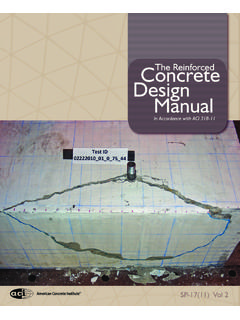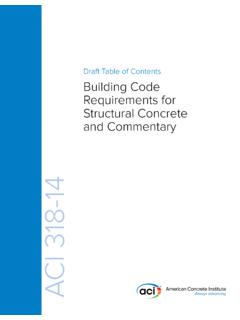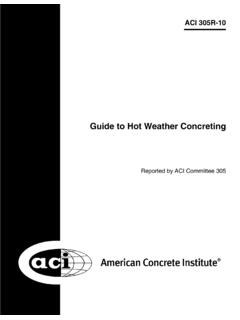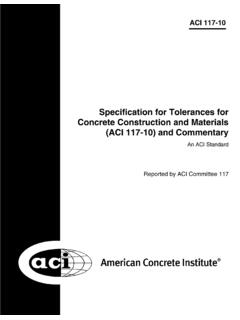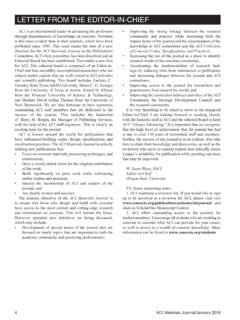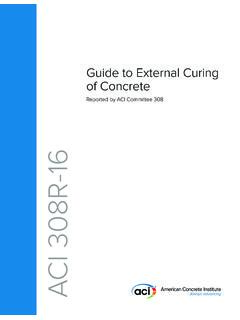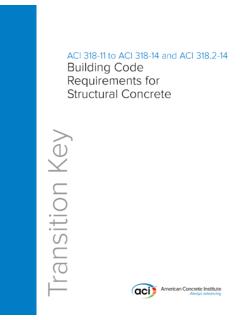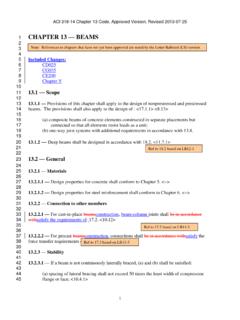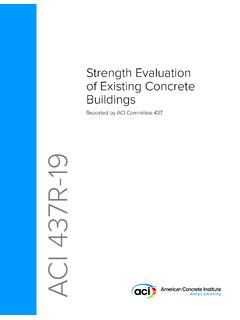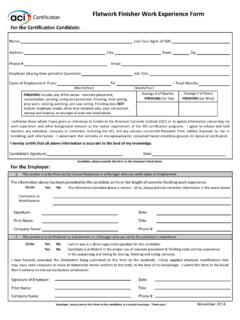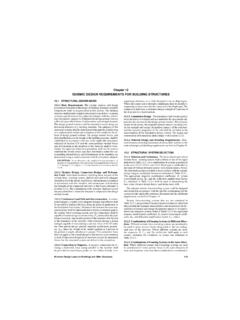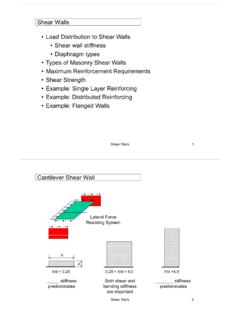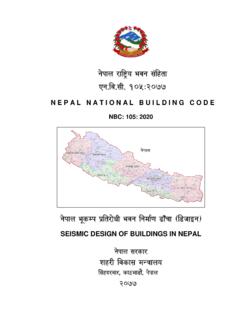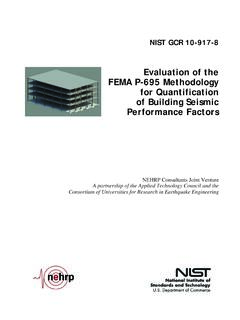Transcription of Guide for the Design and Structures ACI 440.2R-17
1 Guide for the Design and Construction of Externally Bonded FRP Systems for Strengthening concrete StructuresReported by ACI Committee 440 ACI PrintingMay 2017 ISBN: 978-1-945487-59-0 Guide for the Design and Construction of Externally Bonded FRP Systems for Strengthening concrete StructuresCopyright by the American concrete Institute, Farmington Hills, MI. All rights reserved. This material may not be reproduced or copied, in whole or part, in any printed, mechanical, electronic, film, or other distribution and storage media, without the written consent of technical committees responsible for ACI committee reports and standards strive to avoid ambiguities, omissions, and errors in these documents.
2 In spite of these efforts, the users of ACI documents occasionally find information or requirements that may be subject to more than one interpretation or may be incomplete or incorrect. Users who have suggestions for the improvement of ACI documents are requested to contact ACI via the errata website at Proper use of this document includes periodically checking for errata for the most up-to-date committee documents are intended for the use of individuals who are competent to evaluate the significance and limitations of its content and recommendations and who will accept responsibility for the application of the material it contains.
3 Individuals who use this publication in any way assume all risk and accept total responsibility for the application and use of this information in this publication is provided as is without warranty of any kind, either express or implied, including but not limited to, the implied warranties of merchantability, fitness for a particular purpose or and its members disclaim liability for damages of any kind, including any special, indirect, incidental, or consequential damages, including without limitation, lost revenues or lost profits, which may result from the use of this is the responsibility of the user of this document to establish health and safety practices appropriate to the specific circumstances involved with its use.
4 ACI does not make any representations with regard to health and safety issues and the use of this document. The user must determine the applicability of all regulatory limitations before applying the document and must comply with all applicable laws and regulations, including but not limited to, United States Occupational Safety and Health Administration (OSHA) health and safety by governmental representatives in the work of the American concrete Institute and in the development of Institute standards does not constitute governmental endorsement of ACI or the standards that it information.
5 ACI documents are available in print, by download, on CD-ROM, through electronic subscription, or reprint and may be obtained by contacting ACI standards and committee reports are gathered together in the annually revised ACI Manual of concrete Practice (MCP).American concrete Institute38800 Country Club DriveFarmington Hills, MI 48331 Phone: + : + Committee Reports, Guides, and Commentaries are intended for guidance in planning, designing, executing, and inspecting construction. This document is intended for the use of individuals who are competent to evaluate the significance and limitations of its content and recommendations and who will accept responsibility for the application of the material it contains.
6 The American concrete Institute disclaims any and all responsibility for the stated principles. The Institute shall not be liable for any loss or damage arising to this document shall not be made in contract documents. If items found in this document are desired by the Architect/Engineer to be a part of the contract documents, they shall be restated in mandatory language for incorporation by the supersedes ACI and was adopted and published May 2017, American concrete InstituteAll rights reserved including rights of reproduction and use in any form or by any means, including the making of copies by any photo process, or by electronic or mechanical device, printed, written, or oral.
7 Or recording for sound or visual reproduction or for use in any knowledge or retrieval system or device, unless permission in writing is obtained from the copyright for the Design and Construction of Externally Bonded FRP Systems for Strengthening concrete StructuresReported by ACI Committee 440 Carol K. Shield, ChairWilliam J. Gold, SecretaryTarek AlkhrdajiCharles E. BakisLawrence C. BankAbdeldjelil BelarbiBrahim BenmokraneLuke A. BisbyGregg J. BlaszakHakim BouadiTimothy E. BradberryVicki L. BrownJohn BuselRaafat El-HachaGarth J.
8 FallisAmir Z. FamRussell GentryNabil F. GraceMark F. GreenZareh B. GregorianDoug D. GremelShawn P. GrossH. R. Trey Hamilton IIII ssam E. HarikKent A. Harries*Mark P. HendersonRavindra KanitkarYail Jimmy KimMichael W. LeeMaria Lopez de MurphyIbrahim M. MahfouzAmir MirmiranJohn J. MyersAntonio NanniAyman M. OkeilCarlos E. OspinaRenato ParrettiMaria A. PolakMax L. PorterAndrea ProtaHayder A. RasheedSami H. RizkallaRajan SenRudolf SeracinoVenkatesh SeshappaPedro F. SilvaSamuel A. Steere, IIIJ ennifer E. TannerJay ThomasHoussam A.
9 ToutanjiJ. Gustavo TumialanMilan VatovecDavid WhiteSarah E. Witt**Co-chairs of the subcommittee that prepared this MembersP. N. BalaguruCraig A. BallingerHarald G. F. BudelmannC. J. BurgoyneRami M. ElhassanDavid M. GaleSrinivasa L. IyerKoichi KishitaniHoward S. KligerKyuichi MaruyamaAntoine E. NaamanHajime OkamuraMark A. PostmaFerdinand S. RostasyMohsen ShahawySurendra P. ShahYasuhisa SonobeMinoru SugitaLuc R. TaerweRalejs TepfersTaketo UomotoPaul ZiaFiber- reinforced polymer (FRP) systems for strengthening concrete Structures are an alternative to traditional strengthening techniques such as steel plate bonding, section enlargement, and external post-tensioning.
10 FRP strengthening systems use FRP composite materials as supplemental externally-bonded or near-surface-mounted reinforcement. FRP systems offer advantages over tradi-tional strengthening techniques: they are lightweight, relatively easy to install, and noncorroding. Due to the characteristics of FRP materials as well as the behavior of members strengthened with FRP, specific guidance on the use of these systems is needed. This Guide offers general information on the history and use of FRP strengthening systems; a description of the material properties of FRP; and recommendations on the engineering, construction, and inspection of FRP systems used to strengthen concrete Structures .
